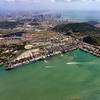CONFINED SPACE: Accident on a Marine Vessel
Was This A Permit Required Confined Space?
By Hector V. Pazos, P.E.
This accident happened in a large compartment of an Offshore Supply Vessel (OSV), which, because of lack of appropriate ventilation and toxic atmosphere it should have been treated as a confined space.
An OSV is a vessel that carries supplies to offshore platforms and rigs drilling for oil and gas in the oceans, such as the waters of the Gulf of Mexico.
Most of the supplies are carried on the cargo deck, but drilling mud and other chemicals are carried below the cargo deck in a compartment designated as "Bulk Mud Room", which on some OSV's may be 60 to 100 feet long.
In this compartment some 10 to 20 large pressurized cylindrical tanks measuring 15 to 18 ft. in diameter and 10 to 12 ft. in height are permanently installed to carry the chemicals. Hence, although the compartment is large, it is pretty well occupied by the tanks, piping and structures, leaving just enough room for two narrow walkways.
The Bulk Mud Room is normally accessed through watertight doors located at the forward end, where the crew quarters are located, and at the after end where the engine compartment is located. The watertight doors are normally closed for safety reasons in case of hull damage and flooding.
Normally, 2 narrow walkways are constructed inside the Bulk Mud Room, one port and one starboard, to reach the engine compartment from the crew quarters, since in the Bulk Mud compartment normally does not have a toxic, or explosive, or asphyxiating atmosphere. But, because the watertight doors are normally closed, two small blowers (one port and one starboard) are installed so the compartment receives some outside air creating positive pressure ventilation.
On the day of the accident, the mate decided to order a crewmember to spray paint the overhead area of the Bulk Mud Room, while the vessel was tied to the dock.
Since it was known that toxic fumes would be generated by the spray paint, in an effort to remove the paint fumes, the rotation of the two small blowers were reversed creating a "negative pressure ventilation" rather than a "positive pressure ventilation", which is the preferred method of ventilation. The worker assigned to perform the spray paint job was provided with a respirator, but without performing any fit testing procedures for tight-fitting respirators. To reach the overhead areas to be spray painted, a 6-ft. aluminum type III stepladder was also provided to fit in the narrow walkway. After the accident, the ladder was found, defective because it had several permanent deformations on the rails and the spreader, and was light duty, 200 lbs. working load.
After some 10 minutes of spray painting, and as it could have been predicted, the worker collapsed from the ladder due to the toxic fumes and fell in the bilges and sustained major injuries.
Despite of the dimensions, the Bulk Mud Room should have been considered a Confined Space because:
a). Has limited means of access or egress;
b). Is not designed for continuous employee occupancy; and
c). A potential hazardous atmosphere was going to be developed and therefore, the OSHA provisions for confined spaces should have been applied.
The employer disagreed with the above and used the argument that it was not a confined space because the watertight doors located some 50 to 60 feet from the area to be painted were left open, making the Bulk Mud Room a non-confined space, and blamed the fall on the employee contending that the employee may have tried to "walk" the ladder instead of descending from the ladder and relocating it. The employee also claims that the damages to the ladder occurred at the time of the fall. The employee, who was seriously injured, testified that he fainted because of the fumes developed by the spray paint process. There were no witnesses.
Regarding ventilation, everybody agrees that the small blowers could not extract the paint fumes, among other reasons, because the intake grills of the blowers were too far from the area being painted. Nevertheless, the employee contended that because the watertight doors to the engine room and crew quarters were left open, the main engine room blowers that supply outside air to the engine room were running because a generator was in service, and this would have been enough to create a draft sufficient to dissipate the paint fumes.
The question still remains: Should the Bulk Mud Room be considered a confined space despite of its dimensions and the paint operation be subject to the Permit Required Confined Space standard in accordance with 29 CFR 1910.146 promulgated by OSHA and adopted by the Department of Transportation of some states, such as Code SB-99-3 of the New York State Department of Transportation?
Or, should the "Bulk Mud Room" be considered a naturally ventilated space when the watertight doors at the forward and after end of the Bulk Mud Room are open?
OSHA standard 1910.146 assigns the responsibility of identifying a space as Permit Required Confined Space to the employer.
This leaves the employer the freedom to blame the cause of this accident on other possible factors, such as misuse of the ladder by the employee.
The author of this article believes that the definition of Confined Space shall be expanded in great detail in an attempt to avoid the type of dispute generated in this case.
Hector V. Pazos, P.E. is a Naval Architect and a Mechanical Engineer, President of Ocean-Oil International Corporation, a consulting group involved with accident reconstruction and providing Expert Witness services to attorneys.














